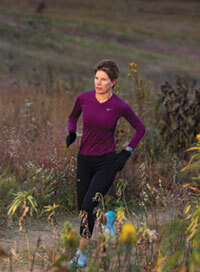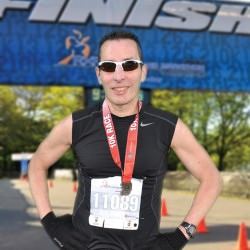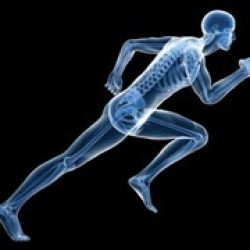Carolyn Smith ’87: Pushing the Limits

A record-setting ultramarathoner, Carolyn Smith can run more than 80 miles in 12 hours. Photo: Andy Manis
Carolyn Smith ’87’s calves have powered her through more grueling miles than most people can even fathom. She ran her first marathon while a student at UW-Madison, and now she’s a record-setting ultramarathoner who can clock more than eighty miles in half a day.
“I like pushing myself,” she says. “How far can the body go, how much can it endure?”
In her case, it’s a lot. In a twelve-hour ultramarathon in 2011, she set the national age-group record and won the overall race, beating her competitors by nearly twenty miles. She was part of the U.S. team that won gold medals in the 100-Kilometer World Championship in 2009 and 2012, and once raced across Death Valley in blistering, 120-degree heat that actually melted her running shoes.
Smith’s addiction to the sport started at age thirteen, and she later ran cross-country and track at UW-Madison under legendary coach Peter Tegen. In 2002, she tried her first ultramarathon, which is defined as any race over thirty-one miles. She has since run more than two dozen.
“One thing I’m most proud of with my running is not necessarily my success, but my longevity,” she says. “I’ve been doing it for this long, and it’s still fun.”
A seven-time member of the U.S. running team who competes all over the world, she recently co-authored the book Running for Women: Your Complete Guide for a Lifetime of Running (Human Kinetics).
Running isn’t just for the young, says Smith, who is forty-seven. “If you look at the statistics, the number of older women who are participating in running is increasing exponentially. There are women in their sixties and seventies who are having tremendous success. They’re setting age-group records and doing these pretty phenomenal things. … We’ve come a long way since women could participate only in the half-mile [event] in the Olympics.” In terms of numbers of competitors, women now dominate every category of races except marathons, she says.
Smith’s own daily schedule is a bit of a marathon. She’s executive director of Marquette University’s Student Health Service, the head medical team physician for the university’s nearly three hundred intercollegiate athletes, and an instructor in the Department of Physical Therapy. By the time she pulls on her running shoes, it’s often 8 or 9 p.m., except when she runs the 26-mile round-trip route to and from work. And then Smith tries to fit in two or three ultramarathons a year. It’s no wonder her running shoes wear out every six to eight weeks.
Next, she’s hoping to compete in the world championship in South Korea in October 2013. “I’m getting close to where I’m ready to stop international competition, but I’d like to go out on a race that I’m proud of,” she says.
And Smith is eager to achieve another goal before hanging up her sneakers for good. “My finale event will be running from one end of the continent to the other,” she says with a smile. That means racing from Washington state to Delaware, 30 to 50 miles a day, for 80 days. Until then, she will continue to ponder the question that has fascinated her for most of her life: what are the limits of human endurance?
“I don’t think we know,” Smith concludes, “but I’m going to keep testing.”
Published in the Spring 2013 issue



Comments
No comments posted yet.